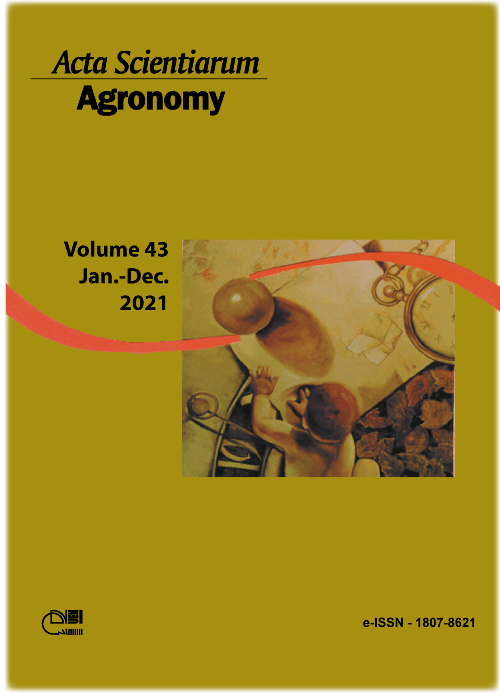Effect of the planting season on carrot cultivars growth and yield in the brazilian semiarid region
Resumo
In regions with high temperatures, carrot cultivation is impracticable, as high temperatures tend to reduce yield and quality of the product. However, with the advent of summer cultivars, carrot cultivation in these regions has become viable. The aim of this work was to evaluate the performance of ten carrot cultivars in different planting seasons. The experiments were carried out at the Rafael Fernandes Experimental Farm of the Federal Rural Semiarid University (UFERSA). The experiments were carried out in May, June, July and August of 2017. The experimental design was a randomized block with ten treatments and four repetitions. The characteristics that were evaluated were the root classification (long, average and short roots); commercial, non-commercial and total yield; dry plant weight and root fresh weight. Both the planting season and the cultivar played important roles in agronomic performance throughout the experimental period. In May and June, the highest average yields and plant growth were obtained (43 and 45 t ha-1 yield, respectively). Hybrid cultivars showed better performance than open-pollinated cultivars in terms of yield. The Brasília, BRS Planalto, and Kuronan varieties showed poor performance in all the evaluated characteristics.
Downloads
Referências
Allen, R. G., Pereira, L. S., Raes, D., & Smith, M. (2006) Evapotranspiración del cultivo. Guías para la determinación de los requerimentos de agua de los cultivos (Estudio FAO Riego y Drenaje, 56). Rome, IT: FAO.
Bezerra Neto, F., Porto, V. C. N., Gomes, E. G., Cecílio Filho, A. B., & Moreira, J. N. (2012) Assessment of agroeconomic indexes in polycultures of lettuce, rocket and carrot through uni- and multivariate approaches in semi-arid Brazil. Ecological Indicators, 14(1), 11-17. DOI: 10.1016/j.ecolind.2011.07.006
Carmo Filho, F., Espínola Sobrinho, J.; Maia Neto, J. M. (1991). Dados meteorológicos de Mossoró - Jan. de 1988 à Dez. de 1990 (Coleção Mossoroense). Mossoró, RN: ESAM/FGD.
Empresa Brasileira de Pesquisa Agropecuária [Embrapa]. (2013). (2013) Sistema brasileiro de classificação de solos (3a ed. rev. e ampl.). Brasília, DF: Embrapa.
Ferreira, D. F. (2007). SISVAR: programa estatístico, versão 5.3 (Build 75). Lavras, MG: Universidade Federal de Lavras.
Groszmann, M., Greaves, I. K., Fujimoto, R., Peacock, W. J., & Dennis, E. S. (2013). The role of epigenetics in hybrid vigour. Trends in Genetics, 29, 684-690. DOI: 10.1016/j.tig.2013.07.004
Lana, M. M., & Vieira, J. V. (2000). Fisiologia e manuseio pós-colheita de cenoura. Brasília, DF: Embrapa Hortaliças.
Lopes, W. A. R., Negreiros, M. Z., Teófilo, T. M. S., Alves, S. S.V., Martins, C. M., Nunes, G. H. S., & Grangeiro, L. C. (2008). Produtividade de cultivares de cenoura sob diferentes densidades de plantio. Revista Ceres, 55(5), 482-487.
Nascimento, W. M. (2000). Temperatura x germinação. Seed News, 4(4), 44-45.
Paulus, D., Moura, C. A., Santin, A., Dalhem, A. R., Nava, G. A., & Ramos, C. E. P. (2012). Produção e aceitabilidade de cenoura sob cultivo orgânico no inverno e no verão. Horticultura Brasileira, 30(3), 446-452.
Pimentel-Gomes, F. (2009). Curso de estatística experimental (15a ed.). Piracicaba, SP: ESALQ.
Resende G. M., Yuri J. E., & Costa N. D. (2016a). Planting times and spacing of carrot crops in the São Francisco Valley, Pernambuco state, Brazil. Revista Caatinga, 29(3), 587-593. DOI: 10.1590/1983-21252016v29n308rc
Seljasen, R., Kristensen, H. L., Lauridsen, C., Wyss, G. S., Kretzschmar, U., Birlouez-Aragone, I., & Kahl, J. (2013). Quality of carrots as affected by pre- and postharvest factors and processing. Journal of Science of Food and Agriculture, 93(11), 2611-2626. DOI: 10.1002/jsfa.6189
Silva, G. O., Vieira, J. V., & Nascimento, W. M. (2011). Estratégias de seleção para germinação de sementes de cenoura em altas temperaturas. Semina: Ciências Agrárias, 32(3), 849-854. DOI: 10.5433/1679-0359.2011v32n3p849
Teófilo, T. M. S., Freitas, F. C. L., Negreiros, M. Z., Lopes, W. A. R., & Vieira, S. S. V. (2009). Crescimento de cultivares de cenoura nas condições de Mossoró, RN. Revista Caatinga, 22(1), 168-174.
Vieira, J. V., & Pessoa, H. B. S. V. (2008). Sistemas de produção. Cultivares. Cenoura. Brasília, DF: Embrapa Hortaliças. Retrieved on May 13, 2021 from https://bitlybr.com/uJbT2Em
DECLARAÇÃO DE ORIGINALIDADE E DIREITOS AUTORAIS
Declaro que o presente artigo é original, não tendo sido submetido à publicação em qualquer outro periódico nacional ou internacional, quer seja em parte ou em sua totalidade.
Os direitos autorais pertencem exclusivamente aos autores. Os direitos de licenciamento utilizados pelo periódico é a licença Creative Commons Attribution 4.0 (CC BY 4.0): são permitidos o compartilhamento (cópia e distribuição do material em qualqer meio ou formato) e adaptação (remix, transformação e criação de material a partir do conteúdo assim licenciado para quaisquer fins, inclusive comerciais.
Recomenda-se a leitura desse link para maiores informações sobre o tema: fornecimento de créditos e referências de forma correta, entre outros detalhes cruciais para uso adequado do material licenciado.




















































